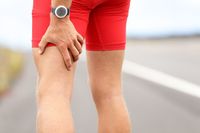 Hamstring strains are an indirect hamstring injury very common in sports involving jumping and sprinting. They are a very common injury and have an extremely high recurrence rate of 12-31%. Anatomy The hamstring consists of 3 large muscles making up the posterior thigh. They attach to both your hip and knee therefore working to bend your knee and also extending the hip. They have a very important role in walking and running as well muscle actions in sport such as jumping and kicking. They are therefore injured performing these movements, either being damaged when sprinting during the late swing phase or over stretched when kicking or jumping. Risk factors There are many different factors that can cause the hamstring being increasingly prone to injury:
Signs and symptoms Hamstring strains are broken into grades, ranging from a small amount of fibres torn to a complete tear of the muscle. The higher the grade the more pain and weakness. Pain usually occurs suddenly during exercise and can lead to:
Immediate management First 48- 72 hours RICER (rest, ice, compression, elevation and referral) and no HARM (no heat, alcohol, heat and massage) protocol for the first 48-72 hours. This will allow reduction of pain, bruising and swelling and encourage healing to the injured tissue. Gentle movements can begin once pain free walking is achieved Rehabilitation To ensure a quicker return to sport and reduce the likelihood of re-injury then an individualised program should be commenced shortly after the injury has been sustained. A program should consist of a graduated strengthening program which is targeting the goals and needs of the patient. Manual therapy can also be used effectively to alleviate pain and promote movement. Return to sport is possible once full strength and flexibility hais returned as well as ability to complete the functional movements of the sport e.g. sprinting or jumping References
0 Comments
|
AuthorDavid McWilliams graduated from Macquarie University with a Doctor of Physiotherapy. He is a member of Australian Physiotherapy Association, Sports and Exercise Physiotherapy Australia, Sports Medicine Australia Archives
April 2021
Categories |
